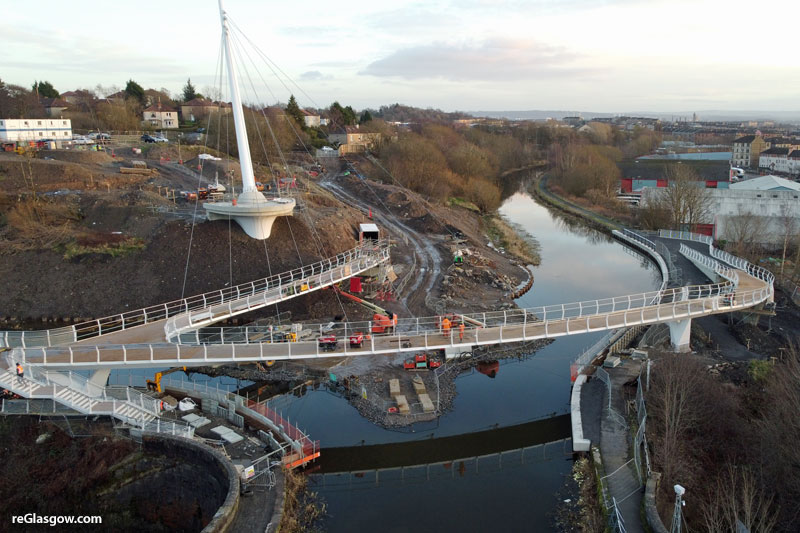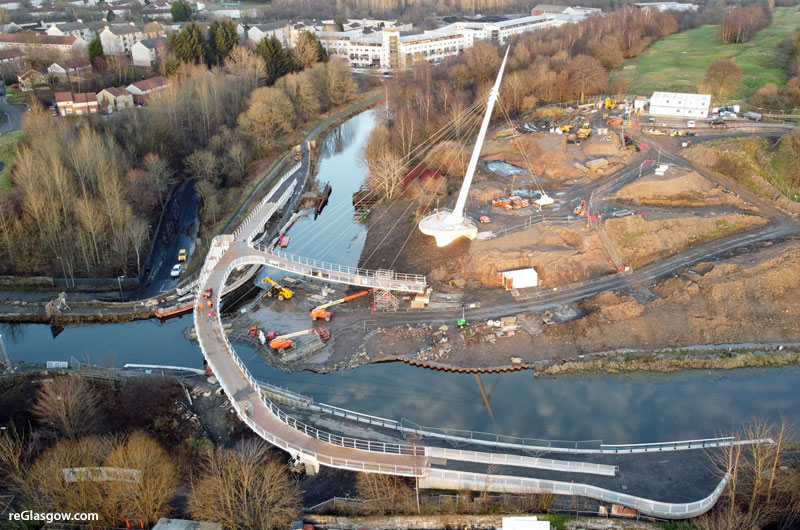
THE construction phase of a £13.7million landmark active travel bridge across the Forth and Clyde Canal in north Glasgow has now concluded
The Stockingfield crossing is on track to open in September once further work is completed.
The bridge has connected the communities of Maryhill, Gilshochill, and Ruchill for the first time since the waterway’s opening in 1790.

It also serves as the final link in the canal towpath, offering a continuous active travel route along the whole length from Bowling on the Clyde to Edinburgh in the east via the Union Canal.
Minister for zero carbon buildings, active travel and tenants’ rights, Patrick Harvie MSP joined two local families to be the first to cross Stockingfield Bridge and reconnect the communities.
He said “It’s fantastic to see the Stockingfield Bridge take final shape and reconnect communities across the north of Glasgow.
“The Scottish Government has provided over £13 million to deliver this project because it unlocks real change in the opportunities that people will have to travel more actively -– improving health, wellbeing and protecting our environment.”

The project, which is being delivered by Scottish Canals with funding from the Scottish Government through Sustrans and the Glasgow City Council’s Vacant Derelict Land Fund, aims to reconnect north Glasgow through the canal towpath.
Funding has been allocated to support groundwork initiatives along the towpath, including a new recreational space and the delivery of eight community artwork installations which celebrate the industrial history of the area.

Richard Millar, chief operating officer at Scottish Canals, said: “This iconic new structure is a major investment and a symbol of change for North Glasgow, continuing the canal regeneration programme that has unlocked millions of pounds of investment.
“After 10 years of planning, the completion of Stockingfield Bridge in September will enable more people to safely enjoy the health and wellbeing advantages of active travel.
“For the first time, locals will be able to move effortlessly from these three communities to the city centre and the west end, providing new access to amenities, services, and employment possibilities.
“The project’s community-led art element will make Stockingfield a completely new destination, attracting new people to visit, raising the reputation of this section of the city to new heights.”
Karen McGregor, portfolio director for Sustrans, said: “The completed construction of Stockingfield Bridge creates invaluable space for walking wheeling and cycling, and represents a significant improvement to the health and wellbeing of the people of North Glasgow.
“Not only does this new connection create a safe and convenient active travel route between Ruchill, Gilshochill, Maryhill and on to the west end and city centre, it opens up a scenic setting for residents and visitors in the area to relax and enjoy what the Forth and Clyde Canal has to offer.”
Stockingfield Bridge will be completed and opened during the 200th anniversary of the Union and Caledonian canals, which have endured the test of time.
Councillor Ruairi Kelly, chair of the Neighbourhoods, Housing and Public Realm Committee at Glasgow City Council, said “The work on the Stockingfield Bridge will deliver real environmental and social benefits to local communities, reconnecting areas and playing an important role in the continued regeneration of north Glasgow.
“In recent years, projects on or close to the banks of the canal have transformed the area, to make it a far more attractive place to use and visit. We were delighted to support the Stockingfield Bridge project, a key development for this part of the city, through the Vacant and Derelict Land Fund.”

